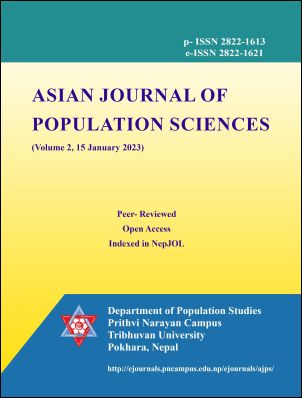Exploring the Lived Experiences of Marital Intimacy among Nepali Married Couples: A Transcendental Phenomenological Approach
DOI:
https://doi.org/10.3126/ajps.v2i1.51088Keywords:
Matiral intimacy, Nepali maried couples, qualitative analysis, semi-structured interviewsAbstract
There is a widespread agreement in the literature that marital intimacy is positively associated with relationship satisfaction. A growing body of literature on marriage and family has focused increasingly on sexual and emotional intimacy. However, little is known about other facets of intimacy. Hence, the objective focuses on exploring married couples' lived experiences of various facets of marital intimacy. The present study is informed by a transcendental phenomenological qualitative approach to analyse data from the semi-structured interviews and generate the overarching themes. Criterion-based purposive sampling of 28 females and males (i.e., fourteen intimate couples) from Pokhara participated in the present study. The thematic analysis demonstrated five significant themes that couples attached to the facets of intimacy such as emotional intimacy (feeling of closeness); social intimacy (social bonding); sexual intimacy (physical and non-physical); intellectual intimacy (enriching each other’s mind) and recreational intimacy (bonding through activities of fun and enjoyment). The results demonstrated that various facets of intimacy are experienced positively in married Nepali couples. This study contributes to the body of current literature by examining married couples' actual intimate experiences and within the context of Bowen's family system theory, which supports the study's findings. The study results have practical implications for marital therapists, counsellors and clinicians. Limitations of the study have been discussed, which are potential future research areas.
Downloads
Downloads
Published
How to Cite
Issue
Section
License
Copyright (c) 2023 Santosh Kumar Gurung, Ramkrishna Chapagain, Sunita Sharma

This work is licensed under a Creative Commons Attribution-ShareAlike 4.0 International License.




